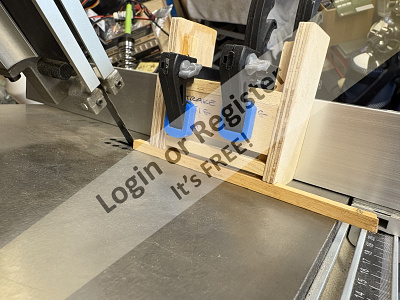Join Us On Social Media!
SRAKES on Classic Model powerboats
35 Posts · 6 Followers · 27 Photos · 145 Likes
Began 5 months ago by
Follow This Thread
Not currently following
> Click to follow
> Click to follow
Latest Post 4 months ago by
( Newest Posts Shown First )
📝 SRAKES on Classic Model powerboats
14 Views · 1 Like
Country: 🇬🇧 United Kingdom
Online: 4 days ago
Online: 4 days ago
Here is a picture of the previously mentioned STRAKE cutting jig in situ on a bandsaw to show how it fits.
Once the table is set over to 45 degrees the jig is simply clamped in position and it is ready to go.
The jig can be simply removed by releasing the clamps, returning the table to horizontal and the bandsaw is then ready cut wood again.




Once the table is set over to 45 degrees the jig is simply clamped in position and it is ready to go.
The jig can be simply removed by releasing the clamps, returning the table to horizontal and the bandsaw is then ready cut wood again.




▲
⟩⟩
PeterL3
Never too old to learn
📝 SRAKES on Classic Model powerboats
18 Views · 1 Like
Country: 🇬🇧 United Kingdom
Online: 4 days ago
Online: 4 days ago
I have also cut bass strakes on your bandsaw using this same simple jig Chris, but it is important to guide the wood more after it leaves the blade to keep it “on track” and to stop it following any errant grain deviations because it cuts quickly and so it is easier for the blade to “dig in” and follow the direction of the grain.
Light pressure on the cut wood (to keep it straight) as it leaves the jig can help to keep the cut on track and produce triangular section strip from square section strip with no failures
Light pressure on the cut wood (to keep it straight) as it leaves the jig can help to keep the cut on track and produce triangular section strip from square section strip with no failures
▲
⟩⟩
PeterL3
Never too old to learn
📝 SRAKES on Classic Model powerboats
21 Views · 2 Likes
Country: 🇬🇧 United Kingdom
Online: 12 hours ago
Online: 12 hours ago
Obeche is a nice timber Bob and is close grained and often "defect" free so I can see why you've used it.
I've got some in stock but don't use it much as it's quite hard and so I tend to use bass most of the time. But in small sections as for strakes I can see it as being ideal as you testify.
I've got some in stock but don't use it much as it's quite hard and so I tend to use bass most of the time. But in small sections as for strakes I can see it as being ideal as you testify.
▲
⟩⟩
PeterL3
zooma
Scratch building 7 Faireys at a scale of 1:12
📝 SRAKES on Classic Model powerboats
18 Views · 3 Likes
Country: 🇬🇧 United Kingdom
Online: 4 days ago
Online: 4 days ago
I have been able to find and check my wood orders Chris, and can confirm that the square section strip that I converted to triangular section wood to use for STRAKES was OBECHIE.
I found the obechie cut cleanly and was flexible enough to bend around the contours of the hull without steaming or soaking in water - but I only secured tiny parts of the length at a time when working around the tightest curves of the bow.
All of the strakes that I have fitted have been secured with a thin superglue and have no other form of attachment.
I was a bit nervous when I first ran my restored Rapier as it was the first hull that I had fitted strakes to using thin superglue only and feared that in use they could peel away from the hull.
To date my Rapier has run regularly since it was restored and gained its strakes during the Covid lock down and the strakes have needed no repairs or maintenance to date .......and it has clocked up a lot of hours being driven fast and hard and survived the inevitable minor collision with unseen submerged debris.
The hull is painted in good old fashioned non-drip household paint (oil based) and I always check after each session to see if any paint has been knocked off or is missing for any reason as I think it gives a valuable protection to the strakes - and perhaps more importantly to the superglue bond?
I found the obechie cut cleanly and was flexible enough to bend around the contours of the hull without steaming or soaking in water - but I only secured tiny parts of the length at a time when working around the tightest curves of the bow.
All of the strakes that I have fitted have been secured with a thin superglue and have no other form of attachment.
I was a bit nervous when I first ran my restored Rapier as it was the first hull that I had fitted strakes to using thin superglue only and feared that in use they could peel away from the hull.
To date my Rapier has run regularly since it was restored and gained its strakes during the Covid lock down and the strakes have needed no repairs or maintenance to date .......and it has clocked up a lot of hours being driven fast and hard and survived the inevitable minor collision with unseen submerged debris.
The hull is painted in good old fashioned non-drip household paint (oil based) and I always check after each session to see if any paint has been knocked off or is missing for any reason as I think it gives a valuable protection to the strakes - and perhaps more importantly to the superglue bond?
▲
⟩⟩
PeterL3
Madwelshman
ChrisF
Never too old to learn
📝 SRAKES on Classic Model powerboats
25 Views · 2 Likes
Country: 🇬🇧 United Kingdom
Online: 4 days ago
Online: 4 days ago
The strakes that I have cut from the basic jig that I made was designed to feed 5mm sqaure wood and I never had to change the basic general purpose saw blade to make it work.
Following the enquiry from Chris (who had guessed that I had used larger 6 mm square strip), I will have a play with making a couple of new jigs to cut smaller sized square wood to see if I can cut the smaller sizes that he likes to use (4mm and 3mm).
I think there should be plenty of “headroom” to drop from cutting 5mm square strip to 4 mm square strip but dropping to cut the 3mm square strip may need a finer pitch band saw blade than I would normally use when cutting bulkheads and keels etc.
Personally, I think the strakes that I make from the 5mm square strips work well in the 12 inch to the foot scale water that we sail in (!), and even their slightly over-scale size actually look really good on the approximately 1:12 scale classic power boats that I fit them onto.
If I were only making my classic model power boats to display and view (including from the underside), I may check more carefully to see if they resembled the full size boats strakes, but my classic model power boats are made to perform in all weathers and conditions and to date I have been very pleased with the look and performance of the slightly over-scale size I have been using.
Having said that, I do like a challenge, and if I can make a jig to perform successfully with the smaller sizes of square section hardwood strip, I will fit some of the smaller sizes strakes to a comparable hull to see if they perform any differently.

Following the enquiry from Chris (who had guessed that I had used larger 6 mm square strip), I will have a play with making a couple of new jigs to cut smaller sized square wood to see if I can cut the smaller sizes that he likes to use (4mm and 3mm).
I think there should be plenty of “headroom” to drop from cutting 5mm square strip to 4 mm square strip but dropping to cut the 3mm square strip may need a finer pitch band saw blade than I would normally use when cutting bulkheads and keels etc.
Personally, I think the strakes that I make from the 5mm square strips work well in the 12 inch to the foot scale water that we sail in (!), and even their slightly over-scale size actually look really good on the approximately 1:12 scale classic power boats that I fit them onto.
If I were only making my classic model power boats to display and view (including from the underside), I may check more carefully to see if they resembled the full size boats strakes, but my classic model power boats are made to perform in all weathers and conditions and to date I have been very pleased with the look and performance of the slightly over-scale size I have been using.
Having said that, I do like a challenge, and if I can make a jig to perform successfully with the smaller sizes of square section hardwood strip, I will fit some of the smaller sizes strakes to a comparable hull to see if they perform any differently.

▲
⟩⟩
PeterL3
Madwelshman
Never too old to learn
📝 SRAKES on Classic Model powerboats
30 Views · 3 Likes
Country: 🇬🇧 United Kingdom
Online: 4 days ago
Online: 4 days ago
This simple jig has been preceded by many failures and is the result of many hours of experimentation - and a lot of wasted wood - before coming up with this simple way of making triangular strip on a bandsaw without waste.
The table of the saw is accurately set over to 45degrees and the jig is then securely clamped into position as close to the cutting edge of the blade as possible.
The blade position to the jig can be checked to be absolutely central to the jig by pushing the square strip up against the stationery blade and checking it with the mark one eyeball before the machine is switched on.
The jigs position on the bandsaw baseplate needs to be checked (and checked again) after the clamps have it held it securely in place before the machine is switched on.
Sometimes feeding the strip in from the opposite end can help the strip to cut square and true if the grain direction is clearly not wanting to run cleanly.
Once completely happy about the position and security of the jig clamping, the square strip is slowly fed into the jig and onto the running blade with slow but firm and constant pressure.
It soon becomes clear when the wood grain wants to pull the strip over to the side of the blade, but by guiding the already cut end after it leaves the blade this "wanderlust" can be controlled perfectly.


The table of the saw is accurately set over to 45degrees and the jig is then securely clamped into position as close to the cutting edge of the blade as possible.
The blade position to the jig can be checked to be absolutely central to the jig by pushing the square strip up against the stationery blade and checking it with the mark one eyeball before the machine is switched on.
The jigs position on the bandsaw baseplate needs to be checked (and checked again) after the clamps have it held it securely in place before the machine is switched on.
Sometimes feeding the strip in from the opposite end can help the strip to cut square and true if the grain direction is clearly not wanting to run cleanly.
Once completely happy about the position and security of the jig clamping, the square strip is slowly fed into the jig and onto the running blade with slow but firm and constant pressure.
It soon becomes clear when the wood grain wants to pull the strip over to the side of the blade, but by guiding the already cut end after it leaves the blade this "wanderlust" can be controlled perfectly.


▲
⟩⟩
PeterL3
Len1
zooma
Never too old to learn
📝 SRAKES on Classic Model powerboats
30 Views · 4 Likes
Country: 🇬🇧 United Kingdom
Online: 4 days ago
Online: 4 days ago
Here are some pictures (as promised) of my simple jig to convert square section hardwood strip into triangular strip - in my case to be used for STRAKES.
As I have marked on the end face (for my own reference) this simple jig is for use with 5mm square hardwood strip.
I will make other sizes to fit different sizes of square strip as it is important to get a good accurate fit through the front, top and back (as well as the saw table base plate and the underside of the strip to be cut) to guide the square strip accurately through the jig as the grain of the wood strip changes direction all along its length and will try to pull itself off of the bandsaw blade to follow its own grain direction rather than stay corrected seated in the jig.



As I have marked on the end face (for my own reference) this simple jig is for use with 5mm square hardwood strip.
I will make other sizes to fit different sizes of square strip as it is important to get a good accurate fit through the front, top and back (as well as the saw table base plate and the underside of the strip to be cut) to guide the square strip accurately through the jig as the grain of the wood strip changes direction all along its length and will try to pull itself off of the bandsaw blade to follow its own grain direction rather than stay corrected seated in the jig.



▲
⟩⟩
PeterL3
Len1
zooma
EdW
Never too old to learn
📝 SRAKES on Classic Model powerboats
32 Views · 4 Likes
Country: 🇬🇧 United Kingdom
Online: 4 days ago
Online: 4 days ago
Hi Chris, you are the current owner of the actual bandsaw that I cut most of my strakes on (!)
The crude little jig that I made can be clamped on to any bandsaw table using simple small clamps.
I will check my wood orders (if possible) to see what type of wood I always buy for my stringers, but it is the same sort of wood that Aerokits and LesRo always supplied in their kits, so it should be easy for a wood expert (not me!) to identify .
When cutting the 1 meter lengths of square section wood I could always "feel" when the direction of the grain was changing - sometimes several times in the same length! - and use my finger pressure to help keep the wood firmly in position against the side of the guide to stop it "running-off".
This became instinct after a time (and a little practice) and got to the stage where I was genuinely able to claim a 100% success rate - no failures due to "run-off".
You are right to suggest that there must be a size of wood that will be too small to split from a square section to a triangular section of wood - probably due to the actual width of the blade being used to cut it.
If I can get some workshop time (in my shed) this winter, I will experiment with this to find out just how small a section of wood that I can split in half using my bandsaw jig - but to date, I have had no problems cutting the size of strake that I have wanted to use on any of my classic model power boats to date.
The crude little jig that I made can be clamped on to any bandsaw table using simple small clamps.
I will check my wood orders (if possible) to see what type of wood I always buy for my stringers, but it is the same sort of wood that Aerokits and LesRo always supplied in their kits, so it should be easy for a wood expert (not me!) to identify .
When cutting the 1 meter lengths of square section wood I could always "feel" when the direction of the grain was changing - sometimes several times in the same length! - and use my finger pressure to help keep the wood firmly in position against the side of the guide to stop it "running-off".
This became instinct after a time (and a little practice) and got to the stage where I was genuinely able to claim a 100% success rate - no failures due to "run-off".
You are right to suggest that there must be a size of wood that will be too small to split from a square section to a triangular section of wood - probably due to the actual width of the blade being used to cut it.
If I can get some workshop time (in my shed) this winter, I will experiment with this to find out just how small a section of wood that I can split in half using my bandsaw jig - but to date, I have had no problems cutting the size of strake that I have wanted to use on any of my classic model power boats to date.
▲
⟩⟩
PeterL3
Len1
zooma
ChrisF
Never too old to learn
📝 SRAKES on Classic Model powerboats
37 Views · 5 Likes
Country: 🇬🇧 United Kingdom
Online: 12 hours ago
Online: 12 hours ago
I know you have successfully cut quite small strakes Bob, are they 6mm (?) on your bandsaw, using a self-made jig but I guess it would be a challenge going smaller than that due to the characteristics of timber. I've had small section timber break easily on me due to natural "defects" in the timber (though this was mainly with mahogany - perhaps bass would be OK?) and think breakages would invariably occur if trying to cut small section strakes if using a band saw or table saw if there is any flex at all applied to the cut timber. What timber do you use Bob?
A suitable guide and then restraint of the cut timber is I think the big challenge with using a table saw is that the timber needs to be accurately aligned as it approaches the blade and then restrained once cut with ideally something matching the strake.
I have thought in the past about planing small square section down but again it's the problem of securing the timber again that's the issue. Ideally it needs to be held in a vee over it's length!
The strakes I use are only 3mm and 4mm and I think it would be almost impossible to cut timber to those sizes in triangular section. Short lengths probably but 900mm? Also I prefer strakes at 60 degrees so that would be another problem!
I did have an issue with a small number of short lengths of styrene strake not bonding using canopy glue but that was due to not holding sufficiently in place until the glue dried. But those issues have now been rectified using cyano. I really like the styrene strakes as they are small, strong and very accurately made and can be steamed to a bend like timber. I've used them on three builds now but when I do the next one I shall use cyano from the off.
A suitable guide and then restraint of the cut timber is I think the big challenge with using a table saw is that the timber needs to be accurately aligned as it approaches the blade and then restrained once cut with ideally something matching the strake.
I have thought in the past about planing small square section down but again it's the problem of securing the timber again that's the issue. Ideally it needs to be held in a vee over it's length!
The strakes I use are only 3mm and 4mm and I think it would be almost impossible to cut timber to those sizes in triangular section. Short lengths probably but 900mm? Also I prefer strakes at 60 degrees so that would be another problem!
I did have an issue with a small number of short lengths of styrene strake not bonding using canopy glue but that was due to not holding sufficiently in place until the glue dried. But those issues have now been rectified using cyano. I really like the styrene strakes as they are small, strong and very accurately made and can be steamed to a bend like timber. I've used them on three builds now but when I do the next one I shall use cyano from the off.
▲
⟩⟩
PeterL3
Len1
hermank
zooma
EdW
Scratch building 7 Faireys at a scale of 1:12
📝 SRAKES on Classic Model powerboats
37 Views · 5 Likes
Country: 🇬🇧 United Kingdom
Online: 4 days ago
Online: 4 days ago
I guess it would probably be best to make your own guide for cutting triangular strip in any case?
It needs to be clamped to the table from both ends as cutting strakes needs a solid fixing guide that has zero movement.
Maybe with that in mind it would be possible to make a 45 degree angled guide to clamp onto the simple Proxxon table saw to split square section strip wood:
The expensive version Proxxon table saw could have the blade set at 45 degrees instead and use a right angle guide.
It needs to be clamped to the table from both ends as cutting strakes needs a solid fixing guide that has zero movement.
Maybe with that in mind it would be possible to make a 45 degree angled guide to clamp onto the simple Proxxon table saw to split square section strip wood:
The expensive version Proxxon table saw could have the blade set at 45 degrees instead and use a right angle guide.
▲
⟩⟩
PeterL3
Len1
hermank
zooma
zooma
Never too old to learn





 Vice Admiral
Vice Admiral United Kingdom
United Kingdom Rear Admiral
Rear Admiral













